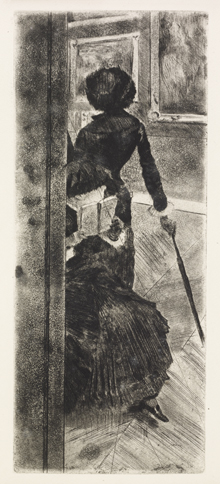
ONCE UNCONVENTIONAL “Mary Cassatt at the Louvre,” by Edgar Degas. |
The work of Edgar Degas has been getting much attention from museums in the past few years. There have been major shows in the UK, recently in Boston, in Washington DC, and many other cities. "Degas: The Private Impressionist" at the Portland Museum of Art gives us a look at some of some of his works on paper and a few photographs, plus works by his circle of friends and a few artists who looked directly to him for inspiration.
Degas was the best draftsman in the Impressionist group. His hero was Ingres, and it would be an interesting competition to assess who had the better hand. They were on different sides of a conceptual continental divide, but drawing is drawing, and they were both really good at it.
In the technical sense Degas wasn't really an Impressionist — he had no interest in ideas about the reality of light and shadow like Monet and Pissarro, and scoffed at painting outdoors. He disliked the title, but he was publicly associated with the group and exhibited with them. His personal relationships with the rest of the group were complicated and uneven, and rendered more difficult in later years by his adamant stance on the wrong side of the Dreyfus affair.
He was radical in his own way. At a time when the French art establishment valued classical or historical scenes, Degas painted launderettes, domestic scenes, horses in action, prostitutes, and dancers, using a viewpoint that looks ordinary today but was unsettlingly unconventional then. His choice of views and subject drew the ire of critics and academicians, but now are admired and emulated.
Consider one of the handful of masterpieces in the show, the etching "Mary Cassatt at the Louvre: The Paintings Gallery"' We see two women, one from behind, probably Cassatt, who leans on her umbrella as she looks at the paintings. Another woman is seated holding a book, perhaps a companion. We are looking through a doorway or from around a corner, with the scene bordered by a wall or doorframe along the left edge. The posture of each of the two figures expresses much about their mood — one deeply engaged, the other inattentive. There's very little detail in the images of the women, but their attitudes are clear.
This version is accompanied by an earlier version, printed from a canceled plate. We can see that Degas was unsatisfied with this earlier one. In the later, better version he added the slightly hidden quality to give it a sense of a private moment. Again and again throughout his body of work, we find ourselves witnesses to privacy. It was Degas's creation of a theater of personal events that Proust (a perceptive art critic) described in one of his passages about his fictional painter Elstir, who was a composite of Degas, Whistler, Monet, and Turner, all of whom, along with Cézanne, Proust himself, and a few others, were the progenitors of central ideas of modernism.